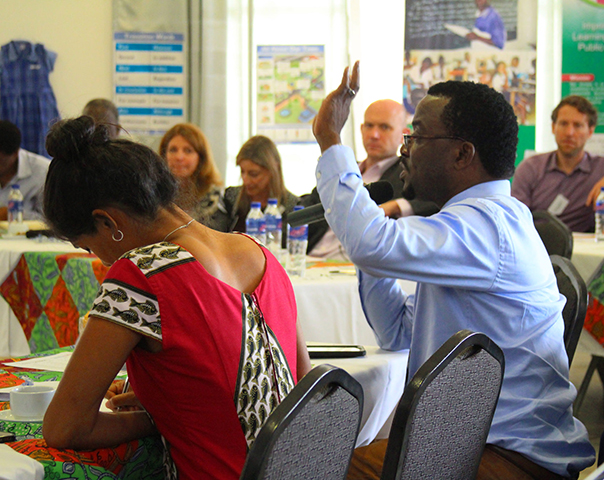What We’ve Learned About Scaling With Governments: A Three-Part Series on Government Partnership, Systems Change, and Getting Incentives Right
Why Scaling and Systems Change Go Hand in Hand
The development field is in the middle of a groundswell, with multiple calls for scaling through the government to amplify impact. Practitioners are converging on a clear message: government ownership from the start, not as an afterthought.
"Now is the time for more 1) evidence & efficiency to use the resources we have as best as possible and 2) embedded local efforts even further within government systems and prioritizing local efforts," says Noam Angrist, from the Blavatnik School of Government (BSG) at University of Oxford.
The track record supports this shift. Where scale has been achieved, government partnerships were central:
"Forget quick fixes—impact multiplies when governments lead. The narrative that governments in low-income countries can't scale health programs effectively isn't just wrong—it's holding back progress. When I look at where we've achieved the biggest scale, it's always through government partnerships," says Kanika Bahl from Evidence Action.
"No more of these transitions to government. Yes! The government needs to own it from the outset," says Nithya Ramanathan, Nexleaf; and Kevin Starr, Mulago.
When IPA began working alongside government partners to design, implement, scale, and institutionalize high-impact programs in 2017, our policy team was small—around 12 people. Today, we have 70 policy staff across 15 countries.
Growing this work over fourfold in eight years taught us that much of what we thought we knew about scaling was wrong. We had to refine our old assumptions about how scaling works, when to engage government partners, and what drives cost-effective implementation at scale.
Over this three-part series, we'll share the most important lessons from that learning journey:
- Part 1: Why scaling and systems change aren't competing priorities—they're the same thing
- Part 2: Why the sector's incentives often work against the cost-effective scaling we all say we want
- Part 3: Why government partnership needs to be your starting point, not your end goal
These lessons fundamentally changed how we approach scaling. We hope they're useful for others navigating the same challenges—especially as the development sector increasingly needs to bridge the gap between research and real-world implementation while working with tighter budgets.
What We Got Wrong: Treating Scaling and Systems Change as Separate Goals
For many years, IPA primarily tracked our impact in terms of specific cases of “scaling what works.” The (worthwhile!) goal was to scale the implementation of “development widgets”—the likes of insecticide-treated bednets, deworming pills, etc.—and thereby track the impact of IPA and our partners’ work in the world.
At the same time, IPA was also helping transform how institutions work: how they make decisions, use data and evidence, and build new skills. But we didn't measure or document these changes as impact. These changes were hard to measure, intangible, and it was difficult to track the direct link between these changes and the improvements we wanted to make in the lives of the people with whom we were working.
We weren’t alone in underestimating how integral systems change is to scaling evidence-based interventions. Throughout our sector, treating systems change and scaling work as separate endeavors was, and still is, common. But this separation can produce oversimplified approaches that fail to capture the complexity of either process. Some of the pitfalls of this approach include:
- Short-term thinking: Focusing only on the rapid expansion of development interventions without investing in long-term institutional change leads to programs that collapse once external support ends, wasting years of effort and resources.
- Fidelity over sustainability: Prioritizing standardized implementation by experts while ignoring the systems change concerns of contextualization prevents local ownership, making programs unsustainable in the longer term.
- Bypassing systems: Another temptation is to try to make the scaling process “apolitical”, avoiding complex political dynamics, power structures, resource battles, and other challenges by creating parallel implementation structures. This may seem efficient initially, but it weakens existing institutions and creates programs that cannot be sustained or integrated into government systems in the long term.
Facing the Reality: Scaling and Systems Change Must Go Hand in Hand
Our policy work quickly confronted us with this reality.
- We worked with our partners to scale evidence-informed education programs, for example, in Ghana and the Philippines. That work quickly faced the reality that education programs, of course, operate within education systems. These systems have existing teacher training standards, student assessments, curriculum development processes, teaching and learning material development and distribution systems, classroom management and instructional practices, decision making at national, regional, district, and school level and more
- We worked to scale effective nutrition interventions, but were quickly confronted with the realities of the health systems that these operate within—systems made up of health worker recruitment, training, and deployment processes; disease surveillance and reporting systems; patient records and data management; community health programs and outreach; and other components.
Throughout all of our scaling work, it became obvious that all development interventions exist within entrenched policy and decision-making architectures, procurement processes, budget allocation mechanisms, and financial management systems.
We found that we could either work to scale programs within those systems, as they were—and come up against all of these existing ways of working and their existing limitations. Or, we could leverage our scaling efforts to strengthen the systems in which we work—and recognize the systems change efforts as good in and of themselves.
When it came down to it, we simply couldn’t scale effective solutions without also changing the systems in which those interventions were operating. And doing so produced a cascade of positive changes, resulting in systems that are more evidence- and data-driven.
Rwanda's Education System: When Scaling Transforms the Whole System
Take one instance of education scaling in Rwanda. The “Pay-for-Performance (P4P)” randomized evaluation conducted between 2015-2018 (Leaver et al., 2021) found that a contract that rewarded teachers for students’ learning gains and their inputs of presence, preparation, and pedagogy, effectively doubled the rate of learning growth. We had strong evidence and engaged partners within the government of Rwanda who wanted to scale. But the whole intervention relied on key changes to the whole system—nationwide data systems and policy changes:
- Accurate, timely, and comprehensive student assessments to measure learning gains that would determine rewards for teachers, centralized in a new database called the Comprehensive Assessment Management Information System (CAMIS)
- A new digital system for managing teachers, called the Teacher Management Information System (TMIS), necessary for teacher placement and collecting other teacher characteristics
- The ability to link student assessment to classroom teachers, to determine P4P bonuses
- New teacher contracts based on performance: the key P4P intervention, that required several policy changes at the national level
Collaboratively making these system changes took over a decade. IPA and the researchers’ first conversation with the government about this idea was in 2013, and this work continues through 2025. By 2024, 89 percent of primary and secondary schools were enrolled in CAMIS, which maintained 158 million data points.
An inflection point came in 2025, when the Ministry of Education incorporated language about the pay-for-performance (P4P) approach into the Teacher Development and Management Policy for 2025-2030. This policy commits the Ministry to "introduce a new Imihigo system for teachers and headteachers, incorporating metrics on teaching performance and learning outcomes" starting in the 2025-2026 school year. This represents the formal adoption of the P4P intervention that began over a decade ago.
As a system-level change, the adoption of CAMIS hasn’t just supported the scaling up of P4P teacher contracts. Through IPA and Georgetown University’s embedded lab in Rwanda, the data in CAMIS was also used to generate termly student performance reports, which helped identify more than 200,000 students who qualified for remedial tutoring in 2024. This enabled the Ministry to address critical learning gaps.
As the development sector faces increasing pressure to demonstrate lasting impact with fewer resources, we can no longer afford to separate scaling from systems change. The lesson for all of us is clear: if we want our interventions to reach millions and last beyond our involvement, we must embed systems change into our scaling strategies from day one.











